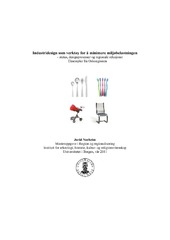| dc.contributor.author | Norheim, Jorid | eng |
| dc.date.accessioned | 2011-08-17T12:58:14Z | |
| dc.date.available | 2011-08-17T12:58:14Z | |
| dc.date.issued | 2011-05-16 | eng |
| dc.date.submitted | 2011-05-16 | eng |
| dc.identifier.uri | https://hdl.handle.net/1956/4880 | |
| dc.description.abstract | This master thesis seeks to investigate how industrial design as a creative economy can contribute to sustainable development. This master thesis is built up on three main topics: regional innovation systems, industrial design and sustainable development. The aim of the study has been to explore how industrial design can contribute to better products, stimulate competition for enterprises and solve environmental challenges in the society as a whole. The fieldwork was conducted in Oslo and was based on fourteen interviews with designers and other participants related to the industry. Those who were interviewed were questioned about driving forces for sustainable design, production processes, effects of being located in the Oslo region, how designers build their social networks and how they market themselves. The empirical evidence combines qualitative interviews with theory and secondary statistical sources. The theoretical background for this thesis is mainly based on literature concerning geography and industrial design, whereas the statistical data are obtained from Statistics Norway. All together the approaches make up a triangulation on the topic. The results show that many design projects are complex and that designers work within different geographical contexts depending on the customer. Compared to private customers, public customers are more likely to buy sustainable design on the basis of their role in the society. Small, as well as large enterprises, work environmentally oriented. However, designers that use methodological tools increase their chances of generating better products. I conclude that designers can contribute with important knowledge on how to reduce our ecological footprints by being more focused on the environmental impact of our products. If one wants to meet the environmental challenges in the future, there is a need for sustainable design. | en_US |
| dc.description.abstract | Oppgaven konsentrerer seg om industridesignnæringen i Osloregionen. Studien ser på hvordan design kan bidra til å minimere miljøbelastningen. Oppgaven baserer seg på intervjuer med designere og andre aktører i tilknytning til design i regionen, der målsetningen har vært å undersøke hvordan designere jobber med miljøspørsmål. En kombinasjon av teori, empiri og sekundære kilder gir en trianguler innfallsvinkel til oppgavetemaet. Den empiriske undersøkelsen viser at designprosjekt ofte er konplekse, og at designere jobber innenfor og på tvers av flere geografiske områder. Oppgaven konkluderer med at dersom vi i i fremtiden skal være rustet til å møte de miljømessige utfordrignene, vil kunnskap om miljøorientert design tvinge seg frem. | en_US |
| dc.format.extent | 930552 bytes | eng |
| dc.format.mimetype | application/pdf | eng |
| dc.language.iso | nob | eng |
| dc.publisher | The University of Bergen | eng |
| dc.subject | Industridesign | eng |
| dc.subject | Miljø | eng |
| dc.subject | Regionale innovasjonssystem | eng |
| dc.title | Industridesign som verktøy for å minimere miljøbelastningen - status, designprosesser og regionale relasjoner. Eksempler fra Osloregionen | eng |
| dc.type | Master thesis | |
| dc.rights.holder | Copyright the author. All rights reserved | |
| dc.rights.holder | The author | eng |
| dc.description.degree | Master i Region og regionalisering | |
| dc.description.localcode | MAHF-REG | |
| dc.description.localcode | REG350GEO60 | |
| dc.subject.nus | 713999 | eng |
| dc.subject.nsi | VDP::Humanities: 000::Architecture and design: 140 | |
| dc.subject.nsi | VDP::Social science: 200::Human geography: 290 | |
| fs.subjectcode | REG350GEO60 | |
